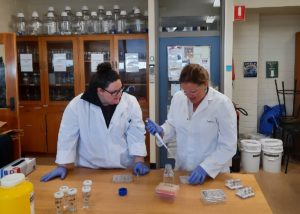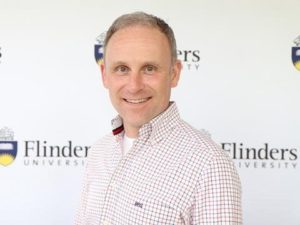
Among success stories for Flinders people this week, a strong female voice steers a COVID-19 leadership group, an optometrist helps with a new national glaucoma guide and lab tests show the effectiveness of a new anti-microbial coating.
Ensuring a strong female voice in COVID-19 leadership group

Associate Professor Sutapa Mukherjee – Associate Professor in Respiratory and Sleep Medicine at Flinders Medical Centre, a member of Adelaide Institute of Sleep Health and president of the Australasian Sleep Association – has also been busy as the female co-chair of the COVID-19 Taskforce Guidelines Leadership Group, which made her a focus of attention nationally on International Women’s Day. Associate Professor Mukherjee was invited to represent the Australasian Sleep Association at the COVID-19 Taskforce and the Guidelines Leadership Group (GLG) in March 2020, as Australia’s peak health bodies scrambled to provide guidance to their members on how to best care for people with COVID-19 across primary, acute and critical care settings. The GLG includes more than 30 of Australia’s leading clinical experts providing clinical governance to the Taskforce and ensure the recommendations meet scientifically rigorous international standards amid the pressure of increasing COVID case numbers, hospital admissions and state lockdowns. When Associate Professor Mukherjee said that this group needed to recognise a strong female perspective, her peers from across the 15 expert panels and groups elected her as co-chair with Associate Professor Julian Elliott. Her full profile is featured in the National COVID-19 Clinical Evidence Taskforce website.
Optometrist helps with new glaucoma guide

Thi Thi Nguyen, an optometrist with the College of Nursing and Health Sciences, was part of a group that worked with Optometry Australia to develop a new Clinical Practice Guide on Glaucoma for Optometrists. The new guide provides evidence-based information about current best practice in the management of glaucoma but is a general guide for optometrists and not a formal management protocol. More emphasis is now placed on: diagnosis requiring the integration of clinical findings including examination of the optic nerve head and visual fields for characteristic, concordant signs; consideration of risk factors; examination of the disc on all patients; concordance of structure and function; individualising the treatment plan; high-quality examination techniques and data-driven diagnoses, and glaucoma as a diagnosis of exclusion and ruling out all other possible optic nerve head or neurological conditions. Glaucoma affects more than 300,000 Australians with half unaware they have it because they haven’t had a comprehensive eye exam. In Australia cases are expected to increase to 379,000 in 2025 when costs are estimated to reach up to $4.3 billion. The Clinical Practice Guide for the Diagnosis and Management of Open Angle Glaucoma 2020 has been uploaded on the Optometry Australia website, updating the previous guidelines from July 2016.
BRIC tests anti-microbial coatings
Laboratory tests at Flinders University have shown the effectiveness of a new anti-microbial coating developed by graphene applications company Sparc Technologies. Results from the tests show the inclusion of a range of Sparc Technologies’ (ASX:SPN) graphene additives to an epoxy coating significantly improved the coating’s anti-bacterial properties against Escherichia coli (E. coli), a common, harmful bacteria. The experiments were led by Flinders Associate Professor Sophie Leterme and researcher Dr Tamar Jamieson from the Flinders Biofilm Research and Innovation Consortium (pictured below). Further laboratory tests are scheduled to evaluate the effectiveness of the company’s graphene coatings technology in repelling additional bacteria and viruses.  Sparc Technologies’ graphene-based anti-microbial coatings systems have applications in areas where the control of bacterial growth on surfaces is important such as hospitals, public areas, food preparation facilities, drinking and wastewater systems and anti-fouling for ships.
Sparc Technologies’ graphene-based anti-microbial coatings systems have applications in areas where the control of bacterial growth on surfaces is important such as hospitals, public areas, food preparation facilities, drinking and wastewater systems and anti-fouling for ships.
“Following on from the very impressive results of earlier work achieved with anti-corrosive coatings, we are now seeing outstanding results with anti-microbial coatings, which encourages us to develop a product for a multitude of anti-microbial coatings applications in multi-billion dollar markets,” says the company’s chief executive, Mike Bartels. The successful tests add to a list of proven applications for Sparc Technologies’ graphene-based products such as in the recovery of precious metals and in the remediation of PFAS chemicals from the environment.
New edition of Human Geography text book released
Distinguished Emeritus Professor Iain Hay is delighted that the fifth edition of his significant text book Qualitative Research Methods in Human Geography has now been published by Oxford University Press. In preparing this new edition, Iain was joined by Professor Meghan Cope of the University of Vermont. The text offers a practical, in-depth guide for undergraduate students of human geography to understand and conduct qualitative research in human geography. Featuring contributions from leading experts from Canada, the US, Australia, and New Zealand, this revised and expanded new edition provides a diverse collection of engaging and relevant examples that illustrate the real-world application of qualitative research techniques. It is now available through Oxford University Press.
Prof Jeroen Hendriks selected for research mentorship

Professor of Cardiovascular Nursing, Jeroen Hendriks, has been offered a new position as a mentee with the Australian Academy of Health and Medical Sciences. The Australian Academy of Health and Medical Sciences welcomed nine new mentees into its Mentorship Program which gives the rising research stars an opportunity to be actively mentored by an Academy Fellow. Professor Hendriks holds a joint position between Flinders and the Central Adelaide Local Health Network, and his his research work examines integrated care in cardiac arrhythmias and associated conditions. Professor Hendriks says he is excited to gain a place on the program. “(It) provides a wonderful opportunity to learn from, be guided by, and potentially work with eminent mentors in the program. With my participation in the program it is my aim to enhance my clinical academic career and to strategically expand my recently started professorial role”.

